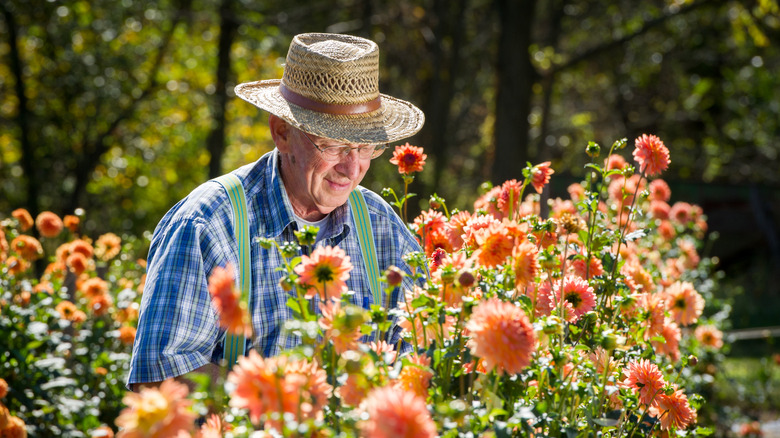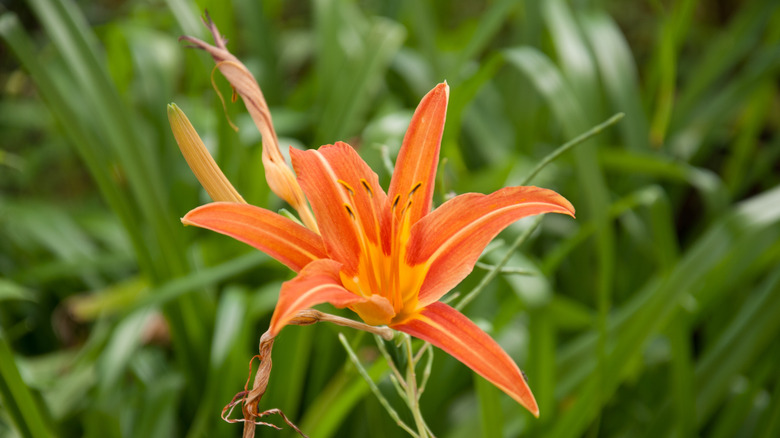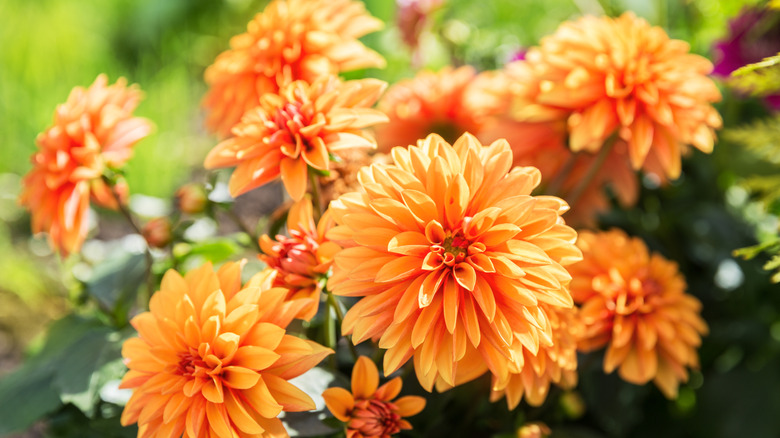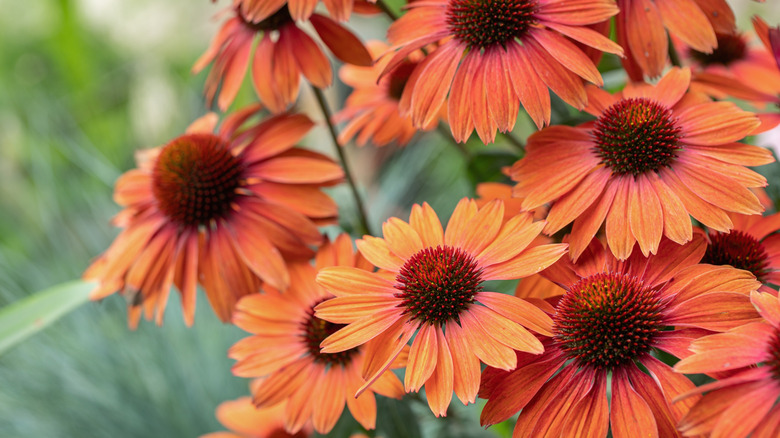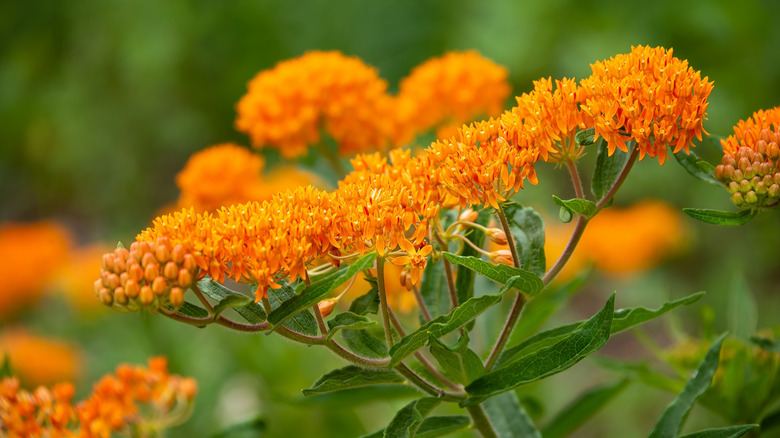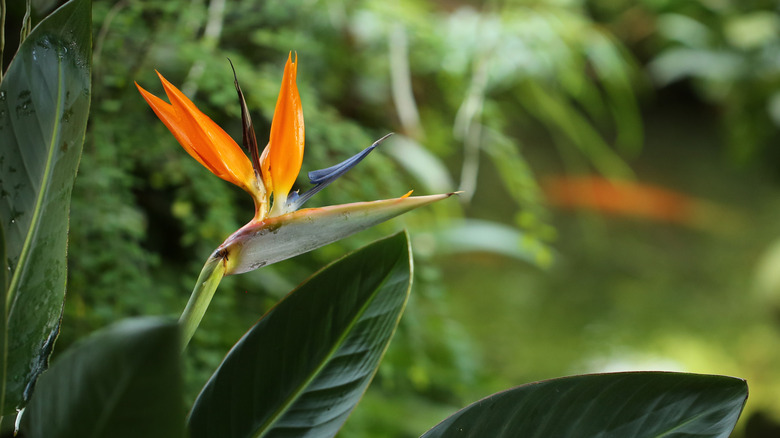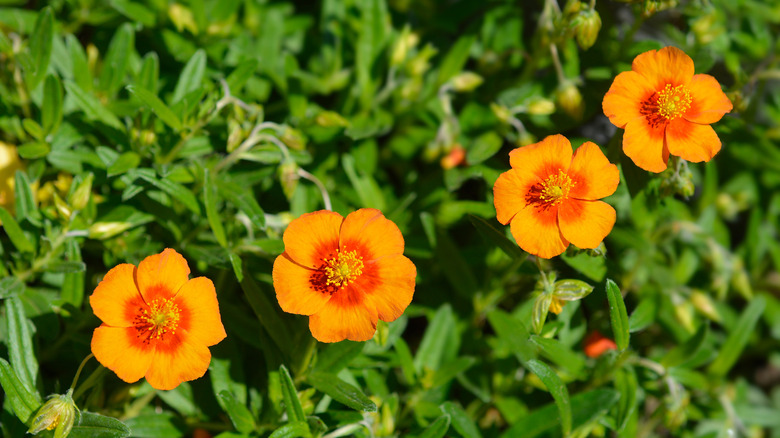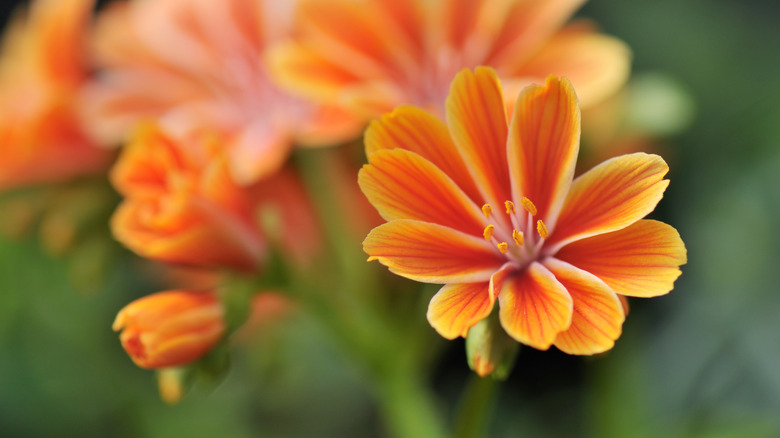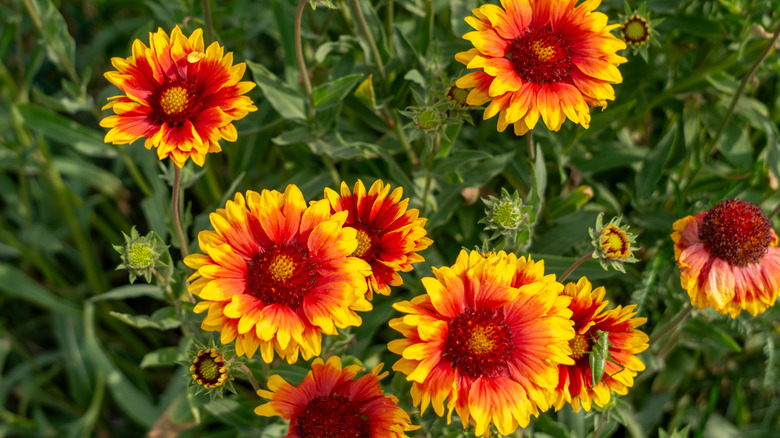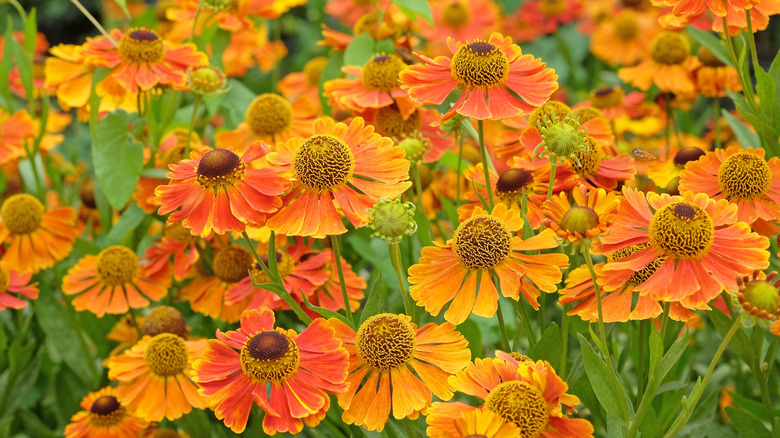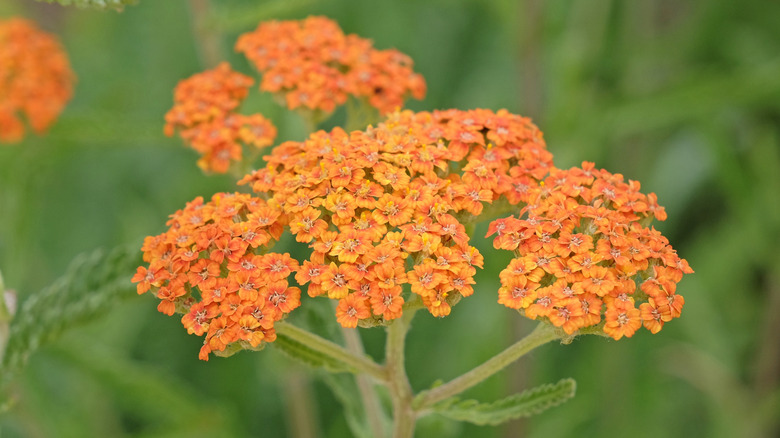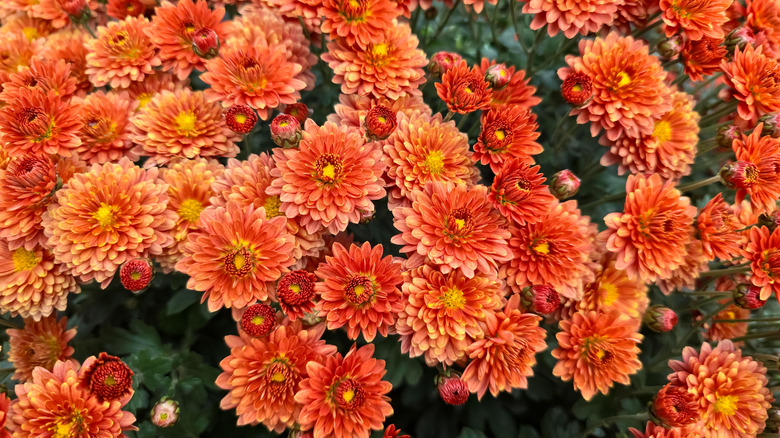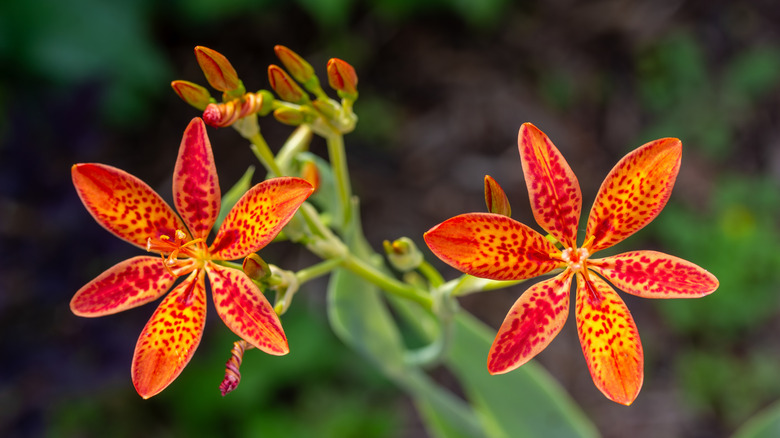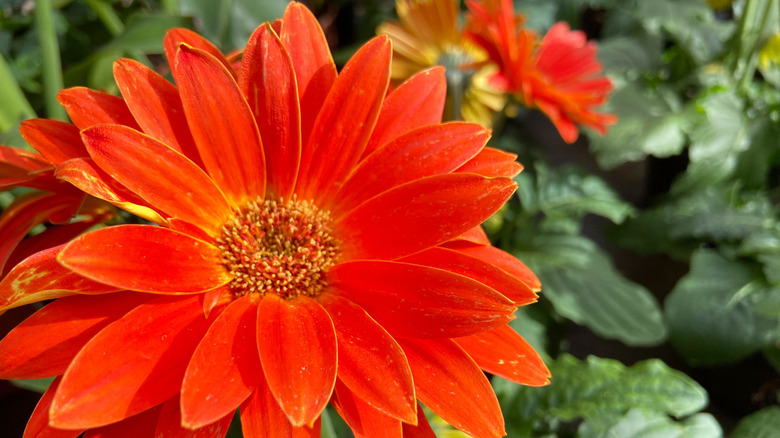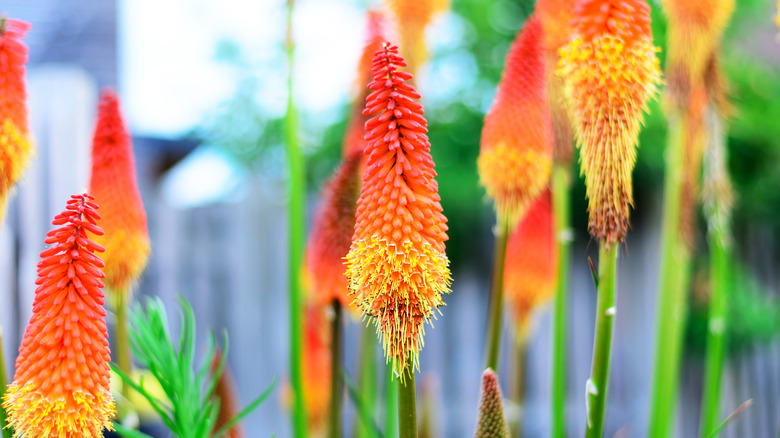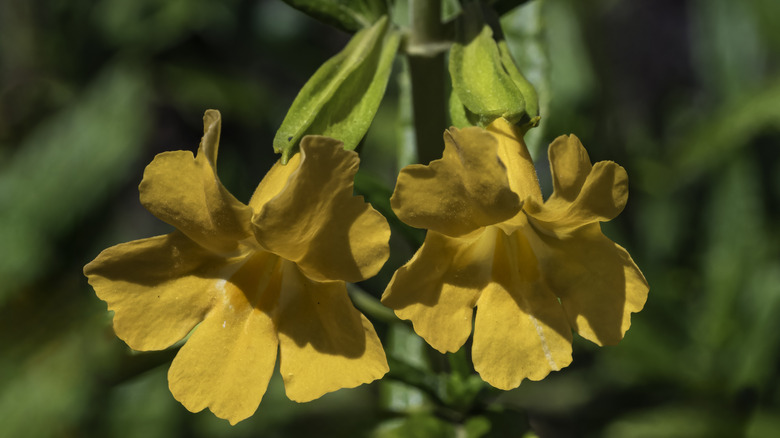17 Gorgeous Perennials To Grow For Stunning Orange Flowers
If you are looking for a bright, bold garden that outshines your neighbors' yards, orange-blooming perennials are the way to go. These plants come back year after year in an explosion of color, marking the summer months and allowing you to bask in the beauty of nature. Whether you are looking for an interesting flower, such as the bird of paradise, to bring a touch of curiosity to your yard, or a more classic bloom, such as dahlias, there is something for you in the wonderful world of orange.
These perennials don't just look good, either. Orange is a favorite color for a lot of butterflies, birds, and bees, so many of these flowers bring pollinators to your garden. More biodiversity and more color! What is not to like about this shade of perennials? However, it can be difficult to know which one to select. With so many orange flowers out there, you have an overabundance of options. That's why we're here to help you with a lineup of our favorite orange perennials to add to the garden.
Daylily
The orange daylily (Hemerocallis fulva) is a striking flower that is hardy in USDA Hardiness Zones 3 to 8. Although it is not technically a lily, you can see why it has the name. Its long, open petals are showy and vibrant, growing up to 5 inches in diameter. Each flower only opens for a day, but the plant will quickly provide you with a new one. Daylilies bloom in July and August, and do well in both full sun and partial shade. They are also pretty good at crowding out weeds.
Dahlia
There is a vast range of show-stopping dahlia garden varieties. In fact, there are 20 different types of dahlias, and quite a few cultivars that provide you with a range of orange shades. For example, the delicate 'Rose Toscano' cultivar brings more gentle, pastel shades to your garden, whereas the bright 'Island Flare' variety provides your garden with stunning, firework-esque blooms. Dahlias thrive in zones 7 to 10 and bloom in summer and fall.
Coneflower
Coneflowers (Echinacea purpurea) are easy-to-grow perennials with cheerful, classic blooms. They are hardy in zones 3 to 8 and do well in full sun or partial shade. Growing up to 4 feet in height, coneflowers really make a statement when they bloom over the summer months. Although coneflowers come in a range of colors, there are some breathtaking orange cultivars to bring into your garden. For example, 'Art's Pride' is a vibrant choice with rich orange petals and dark green leaves. Coneflowers are also attractive to pollinators and will bring biodiversity into your garden.
Butterfly weed
Butterfly weed (Asclepias tuberosa) is definitely an orange flower to consider if you want to boost the butterfly population of your yard! This perennial produces clusters of bright orange blooms and brings a wildflower look to your yard. Thriving in full sun or partial shade, butterfly weed is easy to maintain and is hardy in zones 3 to 9. However, if you do decide to plant butterfly weed in your yard, know that it can spread pretty quickly. Removing the seed pods before they split will help you keep the plant from taking over.
Bird of paradise
If you are looking for a more intriguing plant and live in a warm climate, the bird of paradise (Strelitzia reginae) is a great orange perennial choice. With its fascinating flowers, which look just like the head of an exotic bird, and its thick, rubbery leaves, the bird of paradise brings texture and interest to your yard. It's hardy in zones 10 to 11 and needs fertile, well-drained soil to thrive. These flowers do best in partial shade and should be fertilized regularly to promote blooms.
Peruvian lily
Another lily that isn't really a lily, the Peruvian lily (Alstroemeria aurea) is a stunning perennial that blooms in shades of yellow and orange with leaves patterned with speckles and streaks. This showstopper explodes into life in early summer, with numerous fiery blooms on each plant. Peruvian lily does well in both full sun and partial shade and is hardy in zones 7 to 10. You may find hybrid strains of this flower in different colors, so check the one you are buying to ensure it is orange.
Sun rose
The sun rose (Helianthemum nummularium) is a lovely perennial that produces simple, five-petaled blooms in late spring and early summer. It is a fairly small plant, only reaching around 1 foot in height. However, what it lacks in height it makes up for in charm! Adding in orange varieties of the sun rose, such as the 'Henfield Brilliant' cultivar, is sure to make a big impact in your yard. These flowers thrive in sunny, dry spots and do well in zones 5 to 7. Sun rose also makes for an excellent ground cover.
Cliff maids
If you are looking to bring some whimsy into your garden, cliff maids (Lewisia cotyledon) may be perfect for you. Native to California and Oregon, cliff maids are small perennials that have fleshy, round leaves and beautiful, open blooms. You can find cliff maids in a range of pastel shades, from soft pinks to more vibrant oranges. They are great for rock gardens and do well in well-drained, fertile soil, and are hardy in zones 4 through 9. Cliff maids can be placed in areas of full sun or light shade and will bloom in late spring and summer.
Blanket flower
Although these perennials are fairly short lived, blanket flowers (Gaillardia) make a huge impact. With their striking flowers that bloom in rich hues of yellow, orange, and red, blanket flowers bring a whole load of life into your yard. Looking like mini sunsets, these flowers arrive in spring and last well into the fall. Blanket flowers need a spot in full sun with decent drainage and are pretty drought resistant once they settle in. During the spring and summer months, make sure you deadhead them regularly to promote new blooms.
Common sneezeweed
Common sneezeweed (Helenium autumnale) is native to many parts of the U.S. and produces a host of vibrant blooms. Hardy in zones 3 to 8, common sneezeweed thrives under full sun and needs rich, moist soil. Watering is necessary for these flowers during the dry periods, and they do benefit from a bit of food in the springtime. There are loads of varieties of common sneezeweed to pick from, such as the intriguing 'Mardi Gras' cultivar, which produces orange petals tinged with yellow and red.
Common yarrow
Common yarrow (Achillea millefolium) is found throughout Asia, Europe, and North America, with its small white flowers often seen popping up in meadows and grasslands across the U.S. However, cultivars that bloom in hues of orange, yellow, and red are just as at home in the garden as they are in the wild. Growing up to 3 feet in height, yarrow thrives in full sunshine and blooms in summer and fall. It is suitable for zones 3 to 9 and is very attractive to butterflies, insects, and bees.
Chrysanthemum
Chrysanthemums, or mums, are a classic choice, with their big, round blooms appearing in a range of sizes and colors, including orange. Breeders have been working on chrysanthemums for centuries, which means that there are now many brilliant cultivars to pick from. Hardy in zones 3 to 9, chrysanthemums are easy to grow and do well in both full sun and partial shade. They are great for busy gardeners, too, as they don't need that much care. A light prune and occasional deadheading will enable these perennials to brighten up your garden year after year.
Blackberry lily
With its captivating colors and iconic spotty leaves, the blackberry lily (Iris domestica) is a fun orange-blooming perennial to add to your garden. Again, this lily is not actually a lily, but its late summer blooms are so striking that we can overlook this misnomer. It is a fairly resilient plant that thrives in zones 5 to 10. Happiest in full sun, the blackberry lily likes moist, well-drained soil. When it settles in, it is tolerant of drought and can be divided easily after three or four years.
Persian buttercup
The Persian buttercup (Ranunculus asiaticus) produces dense, cup-shaped blooms that bring a touch of class into your yard. The orange varieties of the Persian buttercup are bright and cheery, lightening up your garden with their stunning blooms in late spring and early summer. They are suitable for USDA zones 8 to 10 and thrive in full sun. Good drainage is a must for Persian buttercups, but they will need some moisture in the soil. When the flowers start to fade after blooming, deadhead the plant to encourage more booms.
Gerbera daisy
There is something nostalgic about the symmetrical bloom of a daisy. Often overlooked, an orange daisy variety brings playfulness into your garden, and one to consider is the gerbera daisy (Gerbera jamesonii). The gerbera daisy can be grown as a perennial in zones 8 to 10 and does well in moist, well-drained soil. They like morning sun and afternoon shade and should be fertilized a few times during the growing season. Flowering in summer and fall, the sunshine blooms of the gerbera daisy are there to keep your garden cheery throughout the seasons.
Red-hot poker
If you like the look of unusual blooms, the red-hot poker plant (Kniphofia uvaria) may be perfect for you. Its name perfectly encapsulates the vibe of this showy perennial, with its upright spikes producing flowers in an ombre of reds, oranges, and yellows. Growing up to 4 feet in height, the red-hot poker plant blooms in early summer, with the flower spikes reaching up above its grassy leaves. It is hardy in USDA zones 5 to 9 and thrives in full sun and well-drained soil.
Sticky monkey flower
Sticky monkey flower (Diplacus aurantiacus) is a fantastic evergreen shrub that becomes covered in orange, tubular blooms in the spring and summer months. It does well in sun or partial shade and is tolerant of drought, making it perfect for warmer climates. It gets its name from the sticky resin that covers its leaves, which deters pests and can help it retain water during dry periods. There are a variety of hybrid sticky monkey flowers available in a range of bright colors that are suitable for bringing into your garden.
